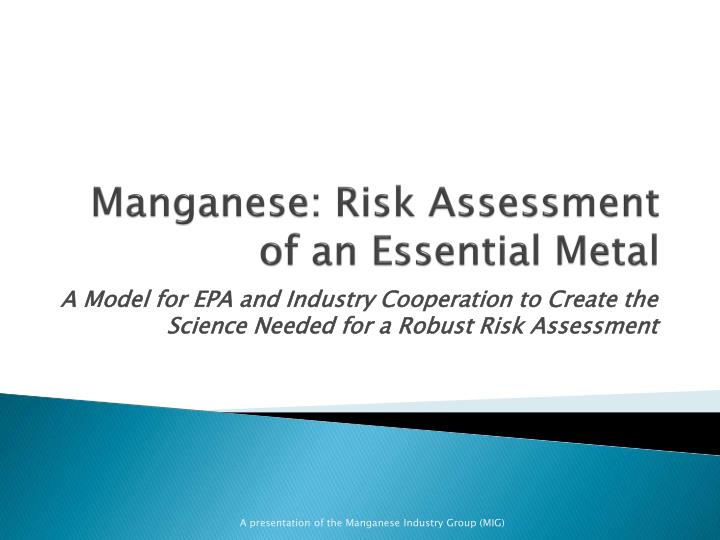



A Mod odel for for EPA and Industry C y Coop ooperati tion to to Create te th the Science Ne Needed fo for a Robust st R Risk sk Asse Assessm ssment A presentation of the Manganese Industry Group (MIG)
The issue in the mid- 1990s ◦ Route of exposure – toxicity of inhaled vs. ingested Mn EPA Designing the approach Research Executing the studies Institutes, Universities Developing the tools General findings Technical Industry Advisory Early applications (Afton) Panels On-going work and a ROBUST SCIENCE new IRIS assessment? A presentation of the Manganese Industry Group (MIG)
“[I]t is possible that a significant fraction of even small amounts of inhaled Mn would be able to reach target sites in the CNS. Thus, the apparently greater toxicity of inhaled versus ingested Mn may reflect important pharmacodynamic and pharmacokinetic differences of Mn that enters the body by different routes. A more definitive understanding of these issues will require more empirical information.” 59 Fed. Reg. 42,227 (August 17, 1994) (emphasis added) A presentation of the Manganese Industry Group (MIG)
“The Agency is adopting health study requirements . . . for use in the development of a physiologically- based pharmacokinetic (PBPK) model intended to accurately predict the disposition of manganese in target tissues of interest following exposure to different manganese compounds. The Agency believes that the PBPK model and associated experimental database should be robust enough to include variations in Mn exposure concentrations and durations, age, gender and species. The [health study] requirements . . . will provide necessary data and information in the development of a Mn PBPK model.” 65 Fed. Reg. 44,775 (July 19, 2000) Studies required under Section 211(b) of CAA A presentation of the Manganese Industry Group (MIG)
The Hamner Institutes for Health Sciences (formerly CIIT Centers for Health Research) completed multiple animal health studies “Pilot Studies Evaluating the Pharmacokinetics of ◦ Inhaled Manganese Tetroxide (Mn 3 O 4 ) and Manganese Sulfate (MnSO 4 ) in Male CD Rats Following Subacute (14-Day) Exposure” “Pharmacokinetics of Manganese Sulfate and ◦ Manganese Phosphate in Young Adult Male and Female and Senescent Male CD Rats Following Sub- Chronic (13-week) Inhalation Exposure” “Pharmacokinetics of Inhaled Manganese Sulfate in ◦ Pregnant and Lactating CD Rats” Pharmacokinetics of Manganese Sulfate in Juvenile ◦ Male Rhesus Monkeys Following Sub-Chronic (13- week) Inhalation Exposure.” All studies were subjected to multiple levels of external peer review by EPA and other experts, Dr. Dorman of CIIT holding including a technical advisory panel, and are rodent inhalation chamber available at www.regulation.gov: docket EPA- HQ-OAR-2004-0074 A presentation of the Manganese Industry Group (MIG)
Inhalation Development of multiple PBPK QP models for Mn Lung & Nose ◦ Rat PBPK model (2007-2008) QC ◦ Olfactory transport model (2007) Olfactory IV, subQ ◦ Primate PBPK model(2008-2009) B + Mn f Mn b ◦ Human adult PBPK model (2011) QBrn Arterial blood Venous blood ◦ Pregnant and lactating adults and Brain Blood neonatal PBPK model (2011) Striatum Cerebellum The PBPK models have adequately B + Mn f Mn b B + Mn f Mn b simulated 54 Mn tracer kinetics following oral and inhalation Rest of body Qbody exposures and also simulated B + Mn f Mn b exposures for various Mn compounds (i.e., MnSO 4 , MnCl 2 ) by Liver QLiv intraperitoneal, intravenous or B + Mn f Mn b Fdietup Oral IP subcutaneous administration in a range of species, including humans. Bile Gut Lumen Peritoneal Cavity Lower GI tract Gut Epithelium Lumen Feces A presentation of the Manganese Industry Group (MIG)
Growing application of the new Mn PBPK models in risk assessment ◦ Ontario Ministry of Environment (2011): “these models have provided a better understanding of the kinetic processes that control tissue Mn levels over a wide range of exposure concentrations through both inhalation and oral exposure.” ◦ The Toxicology Excellence for Risk Assessment (TERA)/International Toxicity Estimates for Risk (ITER) (2011): “[t]his proposed range of values is fairly different from values already loaded on ITER, but it uses the most recent epidemiology studies and PBPK models” and therefore “is likely to be valuable to the risk assessment community as well.” ◦ Agency for Toxic Substances and Disease Registry (2012): “PBPK models provide a scientifically sound means to predict the target tissue dose of chemicals in humans who are exposed to environmental levels (for example, levels that might occur at hazardous waste sites) based on the result of studies where doses were higher or were administered in different species.” A presentation of the Manganese Industry Group (MIG)
International Manganese Institute sponsoring an independent, 3 rd party assessment ◦ Risk Sciences International, Inc. ◦ (University of Ottawa, McLaughlin Centre for Population Health Risk Assessment, Dr. Daniel Krewski) ◦ Categorical regression analysis ◦ PBPK Mn model analyses ◦ Initial results expected later this year IRIS Mn review? A presentation of the Manganese Industry Group (MIG)
Recommend
More recommend